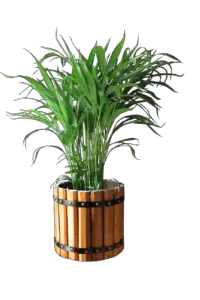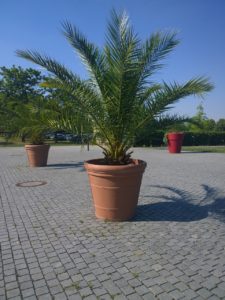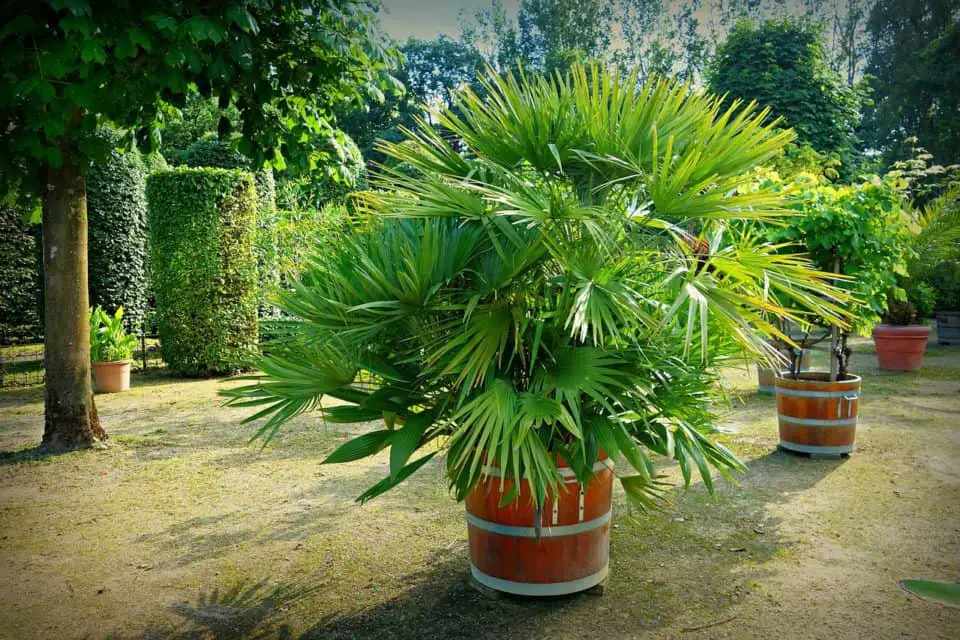Some links in the post are affiliate links and I get a commission from purchases made through some links found in the post.
Kentia palms have for long graced the parlors and homes of British royalty. Even Queen Victoria wanted them around her coffin, thanks to their undeniable elegant touch.
This great looking plant has helped gardens look beautiful, to help position it in the right place outside we have a guide for creating your own beautiful landscape here.
Over time, the plants have become commonplace in households. Budding and experienced gardeners deeply appreciate the resilience of this plant and its low maintenance.
While there are many varieties of this plant, two seem to have taken center stage. These are:
Thatch Palm
The thatch palm features long green fronds that can grow to lengths of up to three meters. For houseplants with a dramatic effect, these are an ideal choice.
Curly Palm/ Belmore Sentry Palm
These have bendy trunks coupled with slightly curled fronds. Queen Victoria took to these quite well.
You can as well consider many of the other options in the market, each with its peculiarities. For this piece, we will focus on kentia palms as a whole:
Can I Put my Kentia Palm Outdoors?
 Most people have their palms indoors, as this is where they thrive the most, as such, growing your kentia palm outdoors can be tricky but not impossible.
Most people have their palms indoors, as this is where they thrive the most, as such, growing your kentia palm outdoors can be tricky but not impossible.
In fact, it comes with its set of advantages. In the outdoors, the plant can reach heights of up to 25 feet which would not be possible indoors.
Plus, in 15 years, the plant can yield flowers, fruits, and seeds. Does that seem like something you would want from this plant?
First things when growing your kentia palm outdoors is, you have to be aware of their growing conditions. Unfortunately, these plants are a tad restrictive and will only do well in USDA plant hardiness zones of 9 to 11.
They also need a semi shady area with good drainage and regular watering.
If you cannot get the correct conditions then they will need to be kept indoors. Please note that moving your kentia palm plant outdoors can trigger transplant shock.
You can cater to this by giving it more water over time until it gets used to the new conditions. By no means does this mean you should leave the soil wet.
Instead, you should aim to keep it moist for a few months until the plant stabilizes. Here are some other aspects to keep in mind:
Positioning a Kentia Palm
The kentia palm outdoors does best in semi-shady areas and will not do well in full sun as the light will burn its foliage.
It is for this reason that the plant does well indoors where the sun is controllable.
Given that you cannot use sheers outside, you need to find a hidden location to give the plant the protection it needs.
Watch out for spotting on the fronds, as this indicates the plant is getting too much light. You may need to shade it or move it (if it’s in a pot).
What Soil to Use for a Kentia Palm
The soil should be well-draining and aerated for a kentia palm.
When planting it in the ground, this can be tricky, but you can solve this by breaking down the soil before planting the palm.
You also need to amend the soil with an all-purpose fertilizer.
Alternatively, you can forgo planting the palm directly in the soil and instead have it in a pot. That way, you can have more control over its sun exposure and move it when necessary.
It also makes it easier to amend the soil. On the downside, you will need to repot the plant at some point.
You will need to amend the soil for palms in containers once a season during Summer, Spring and Fall.
Use a slow-release fertilizer on the soil and water it to soak through the whole container. That should be enough for that season. Do not amend the soil during winter.
Ensure that the container has adequate drainage and does not have blocks at the bottom.
Otherwise, water may sit in the pot, encouraging root rot and ultimately killing the plant.
Pruning a Kentia Palm
It’s easy to get carried away with pruning your kentia palm plant as it grows larger. However, you are better off trimming the foliage twice every year to reduce the stress on the plant.
Use sterilized sharp shears on the leaves and make clean cuts. Using blunt objects injures the leaves and exposes them to diseases.
Cut away the dead foliage and leave the plant be. Otherwise, too much pruning can permanently damage the trunk and leave the plant susceptible to fungal diseases.
Watering a Kentia Palm
For the first few months before the plant adjusts to its new home, it will need more watering.
However, you should not overwater it. Ideally, the watering should take place once or twice each week based on the soil’s dryness.
Always make sure that the top two inches of soil are dry before watering the soil. Also, check the soil’s drainage.
If it’s not effective, root rot can occur. It also helps to occasionally mist the plant to create a humid environment which encourages the plant to thrive.
Do not go overboard with the overwatering, as this can lead to discolored fronts, yellowing tips, drooping and browning leaves.
If you notice such signs, stop watering the plant and move it to a place where the soil can dry.
You should also look out for signs of root rot and transplant the plant if needed.
Please note that this is only possible when the plant is in a container where you can control the roots.
Otherwise, for plants in the ground, your best bet lies in halting watering and waiting for the soil to dry.
Underwatering is just as bad and will also show in a change in the appearance of the leaves. Adjust the watering accordingly, and the plant should be fine.
In winter, you need to change the watering schedule as the plant will not need much water. You can limit the watering to only when the soil becomes too dry.
Transplanting a Kentia Palm
 If you move your kentia palm plant outdoors in a pot, you will need to repot it now and then.
If you move your kentia palm plant outdoors in a pot, you will need to repot it now and then.
Please note that the plant has very fragile roots, and these require very precise handling. If you damage these, the plant could die.
Transplanting is only necessary when the roots become rootbound because it generally does not do well with disturbance.
In indoor conditions, it does not happen much because the plant grows at a slow rate.
However, in the outdoors, the kentia palm plant will grow quite fast, and you may find yourself moving it to bigger containers every three years.
Overall, the plant should do well if it’s in the correct hardiness zone and enough care practices are in place.
Please note that it is a tropical plant which is found in Lord Howe, and it thus needs a semblance of this in its new home.
Try and mist it as much as you can, and if it does not do well outdoors, you can always move it indoors where you can achieve more control over its growing conditions.
If a kentia palm isn’t for you, check out our comparison of kentia palm vs areca palm.
Where to put Your Kentia Palm
The palm does well even in conditions of neglect as long as it has enough water and nutrients.
If you want it to thrive, you have to give it the best care that starts with the proper positioning.
Generally, the plant is a slow grower in indoor and outdoor conditions, though it reaches taller heights in the latter.
It needs to be in a place with enough but indirect sunlight, preferably in the morning and afternoon.
Figure out what space in your outdoors does not receive bright noon sun and place the plant there. Otherwise, the sun’s rays could burn the plant and ruin its beautiful foliage.
Why are Kentia Palms so Expensive?
Let’s start with the fact that most of these plants are grown in the field, and it takes a long time for them to reach the height at which they can be sold.
Keep in mind that these are slow growers and farmers have to wait a while to see the results of their hard work. It takes almost six years for the plant to reach the sale stage.
Additionally, the plants need to go through acclimation in nurseries before they are ready for indoor growing, which again comes out of the farmer’s pocket.
For all this effort and time, farmers must charge a tidy price for their produce.
Is the Kentia Palm Poisonous to Humans or Animals?
This palm is non-toxic to humans and pets. As such, you can grow it at any place in the house, even outdoors, without worrying about your pets dying after consuming it.
Your pets may nibble on it, and it won’t do them any harm. They likely will not eat it, though, as it is unpalatable. Either way, it’s not harmful.
Is a Kentia Palm an Air Purifier?
Like most indoor plants, the kentia palm is a known air purifier. Its leaves and roots absorb gases which they process as well as pollutants.
As they breathe out the oxygen and take in the contaminants in the air, breathing becomes much easier.
You will even find that you sleep much better and are less susceptible to allergens in the home. Your physical health should be much better as a result.
Additionally, this plant brightens up your interior with its green foliage.
Science shows that livening up a space increases the happy hormones coursing through your body and makes you enjoy your space more.
You will even get more satisfaction from the plant when it’s at its best, hence the need for proper care practices.
Final Thoughts
 Most kentia palm growing problems result from underwatering, overwatering, too little and too much sun.
Most kentia palm growing problems result from underwatering, overwatering, too little and too much sun.
If you can strike a balance between these extremes, your kentia palm plant will do well indoors and outdoors.
Happy Gardening!
Before you go, here are some more related articles I encourage you to read below to help solve more of your gardening issues:
How to fix your kentia palm problems.
How Do You Save An Overwatered Palm Tree
Areca Palm Diseases and How to Cure Them
How to Fix your Sago Palm Problems
Written by: Daisy Njeri

